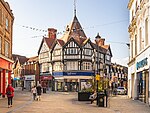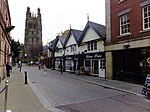The Talbot, Wrexham
20th-century establishments in WalesGrade II listed buildings in Wrexham County BoroughGrade II listed hotelsGrade II listed pubs in WalesHotels established in the 20th century ... and 4 more
Hotels in WalesPubs in WrexhamTourist attractions in Wrexham County BoroughUse British English from July 2023

The Talbot is a former pub and hotel in Wrexham city centre, North Wales. It was built and opened by 1905 replacing an older inn also known as The Talbot or the Talbot Inn. The current building consists of a polygonal Tudor Revival façade structure and is situated in between Wrexham's Hope Street and Queen Street, with the building also extending further across Queen Street. A hotel styled as the Talbot Hotel also operated on the first floor of the building. It stopped operating as a pub and hotel in 1966, later being converted into retail space (now Boots Opticians), although part of the building briefly served as a bar known as The Talbot in 2008.
Excerpt from the Wikipedia article The Talbot, Wrexham (License: CC BY-SA 3.0, Authors, Images).The Talbot, Wrexham
Hope Street, Wrexham City Centre
Geographical coordinates (GPS) Address Nearby Places Show on map
Geographical coordinates (GPS)
| Latitude | Longitude |
|---|---|
| N 53.045988 ° | E -2.993738 ° |
Address
Vodafone
Hope Street
LL11 1BB Wrexham, City Centre
Wales, United Kingdom
Open on Google Maps











